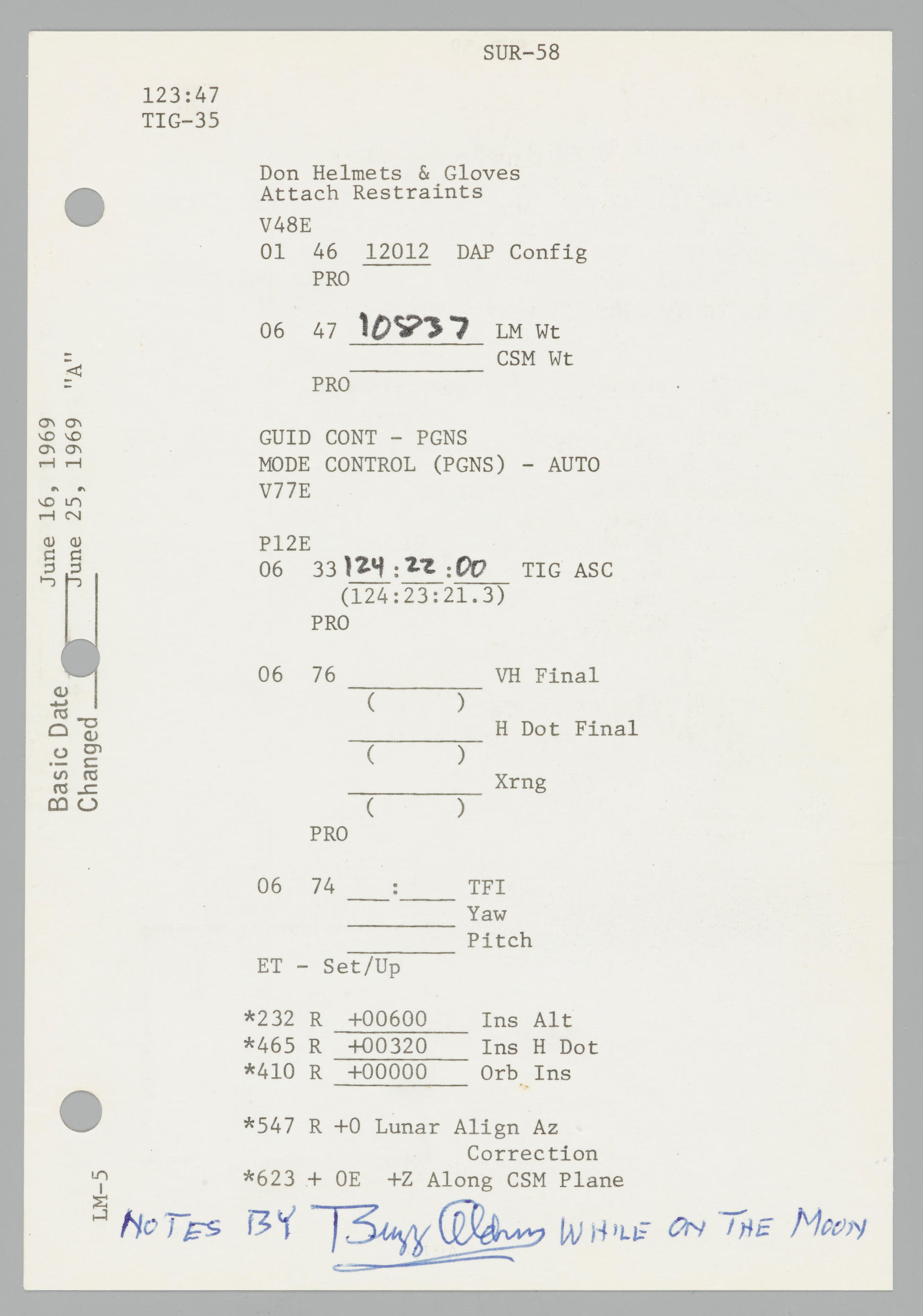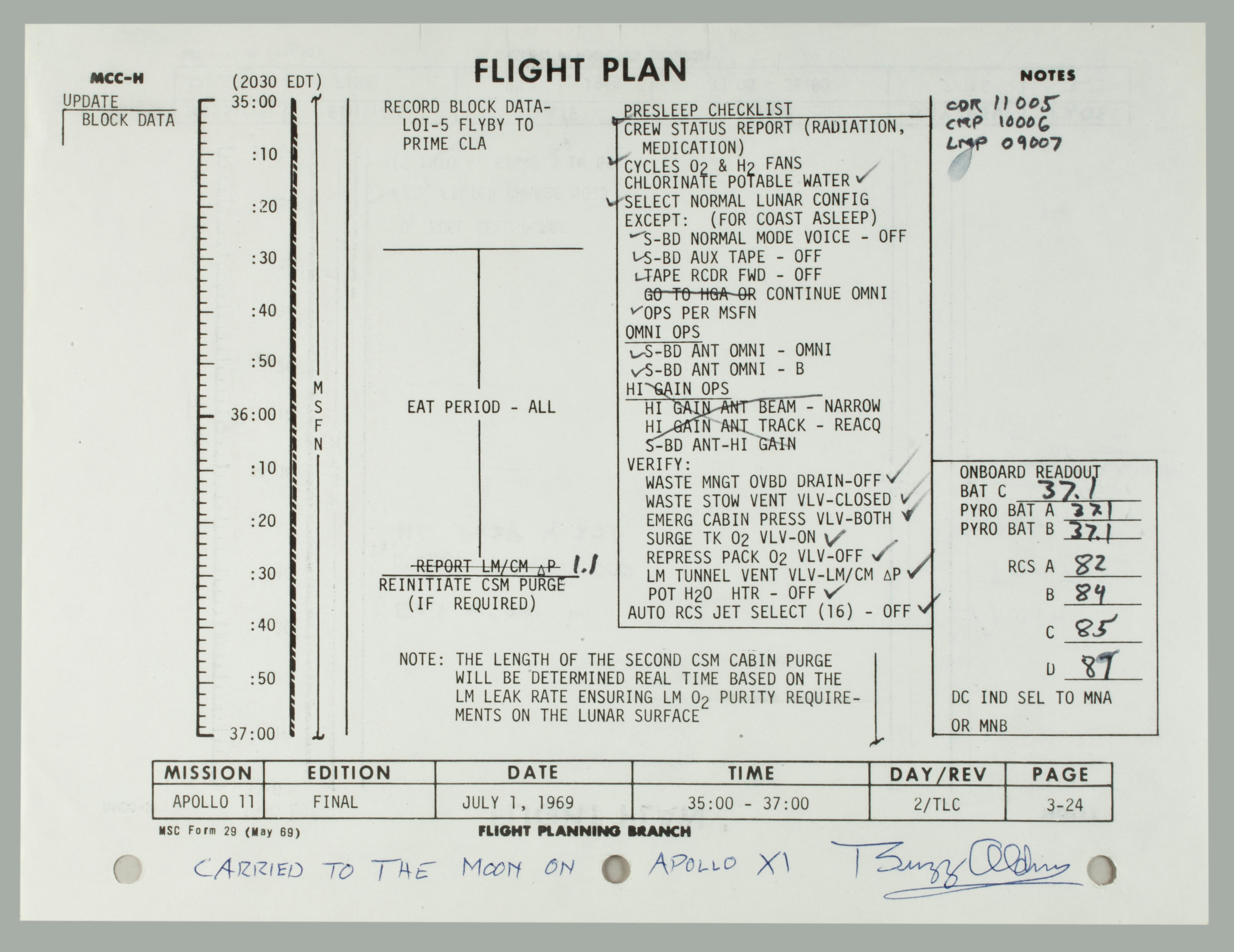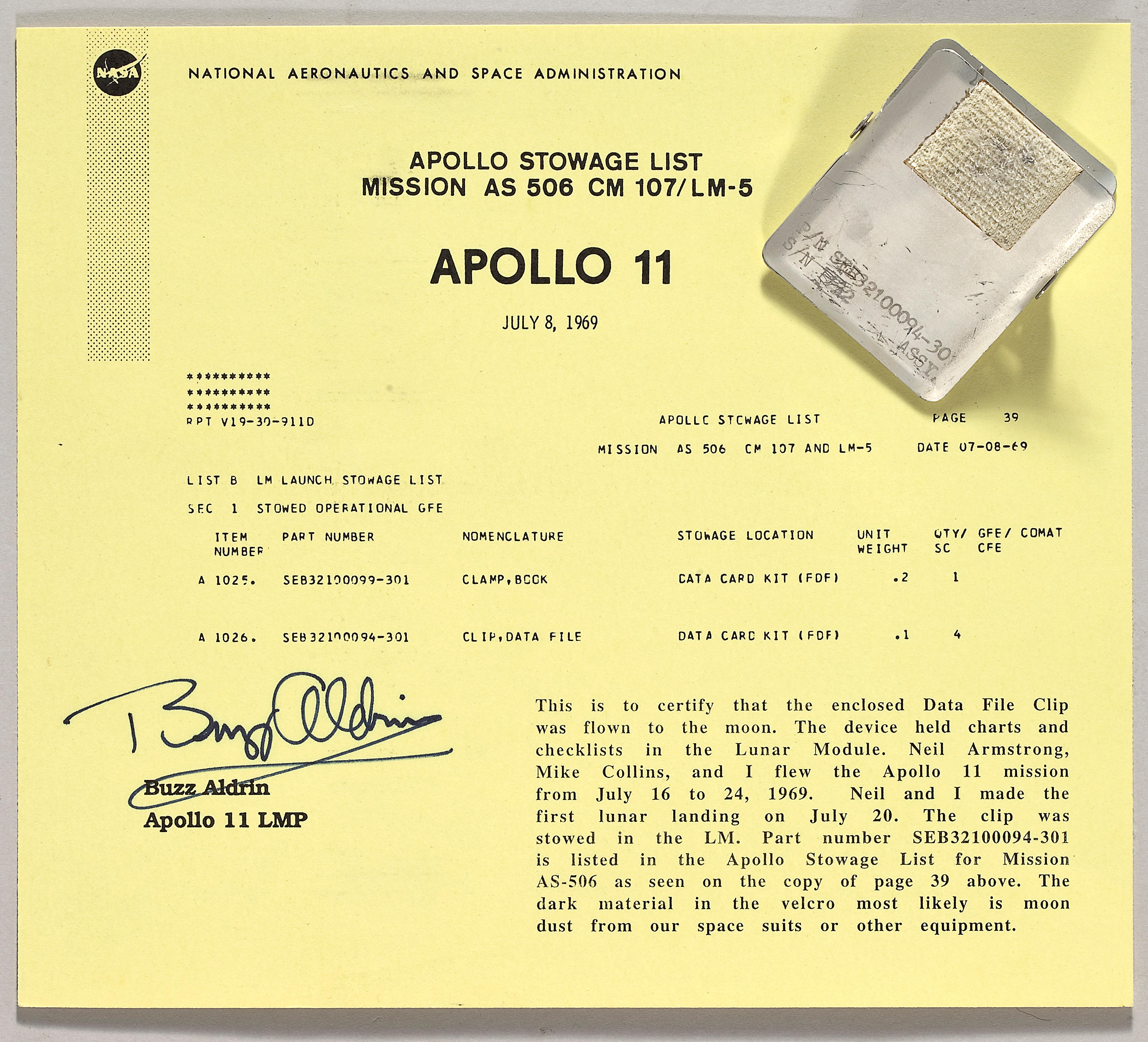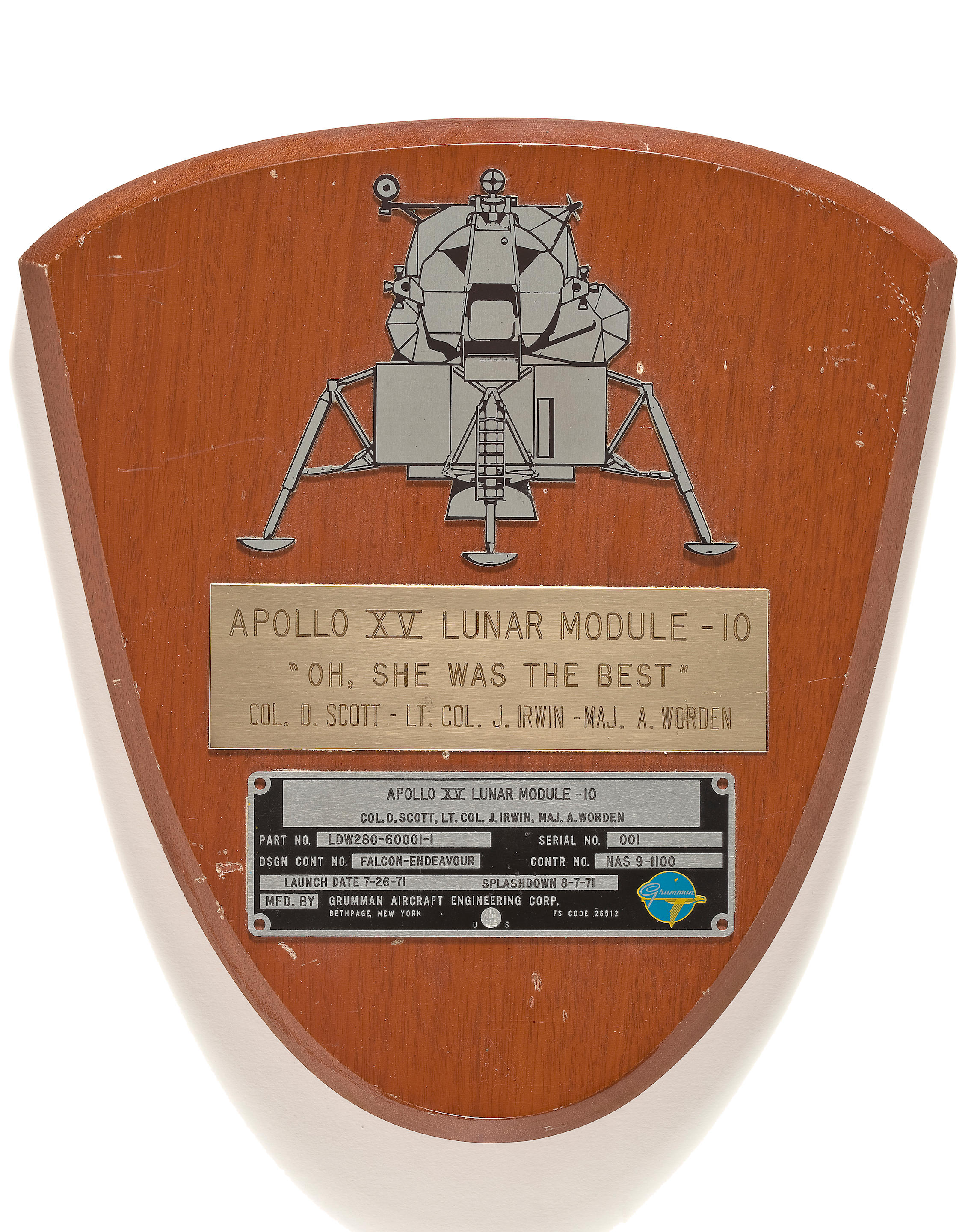Two flown sheets from the Apollo 11 LM G & N Dictionary, 4 pp being "PGNS-15 to "PGNS-18," printed recto and verso. NASA/MSC, May 29, 1969, revised June 23, 1969. Each 8 by 5½ inches. With a Typed Letter Signed by Aldrin. BUZZ ALDRIN'S two-page letter reads: "Enclosed with this letter are two sheets numbered PGNS-15/16 and PGNS-17/18 from the Apollo 11 LM G and N Dictionary, Part No. SKB32100074-361, S/N 1001. It is part of the entire document that was carried to the lunar surface in Lunar Module Eagle on the first lunar landing mission during July 16 to 24, 1969. These sheets are from the Primary Guidance and Navigation Section (PGNS) and have computer procedures to perform the lunar lift-off to enable Neil Armstrong and I to leave the Moon. These are some of the most significant pages from the entire dictionary. Page PGNS-15 has the P06 or PGNS Power Down Program steps to put the flight computer into a standby mode. The most important steps are the ones listed under P12 POWERED ASCENT. This was the program to enable lift-off from the Moon. Neil Armstrong and I were ready to implement these steps immediately after our lunar landing on July 20 if an emergency arose. We also had this page available during predetermined abort periods throughout our lunar stay if an early lift-off was needed. The lunar landing was an experience I will always remember. As we say at NASA, all was 'nominal' until our instrument LM panel flashed a '1202' program alarm. Neil and I asked Mission Control about this because we had never seen it before in any simulation. After some very tense moments, Houston finally radioed that we were 'GO on that alarm.' That was good news but not that reassuring when a few seconds later the same alarm occurred. The alarm coincided when I keyed the computer for the difference between our radar based altitude versus the computer guidance system's value. The alarm indicated that the computer was overloaded with too many tasks. About 3 minutes later, an additional alarm '1201' flashed. Mission Control told us that it was of the same type as the '1202' and that we were still 'GO' for landing. Some eight minutes into our descent engine burn, we started our most challenging part of the landing—the approach phase sequence. We were behind on flight tasks due to the distractions caused by the alarms. Neil was monitoring our instruments and the visual view out his window. He constantly cross-checked Eagle's descent rate with the descent rate data grid from our LM Timeline Book. We had just pitched over and got our first good view of a landing area. We were farther down range than expected. I had to focus on the computer descent readouts as Neil monitored the area the computer was targeting for landing. Neil's flying tasks suddenly became more complicated because the computer was sending us into a large crater containing and surrounded by boulders. At about 500 feet above the lunar surface, Neil Armstrong entered the commands to manually fly Eagle to the lunar surface with computer support. He slowed the descent rate to just a few feet per second and studied the surrounding terrain. Neil asked me about our fuel status and I indicated we had 8 percent remaining. I was then able to glance outside and began to understand why the landing sequence was taking longer that planned—the craters, rocks, and boulders seemed to be everywhere. Mission Control radioed we had '60 seconds' of fuel remaining. I made more data calls. Then '30 seconds' rang in our headsets. Neil was almost to the surface when a haze of dust was kicked up by engine exhaust. He could not see the surface and had to locate something just above the dust cloud. Finally, Neil was able to see a rock that appeared fixed in the stream of dust. This gave him a surface reference and he expertly nulled out a slight backward drifting motion and corrected for a small sideways drift. Just as Neil placed Eagle gently on the lunar surface, I spoke the first words from the Moon: 'CONT
Two flown sheets from the Apollo 11 LM G & N Dictionary, 4 pp being "PGNS-15 to "PGNS-18," printed recto and verso. NASA/MSC, May 29, 1969, revised June 23, 1969. Each 8 by 5½ inches. With a Typed Letter Signed by Aldrin. BUZZ ALDRIN'S two-page letter reads: "Enclosed with this letter are two sheets numbered PGNS-15/16 and PGNS-17/18 from the Apollo 11 LM G and N Dictionary, Part No. SKB32100074-361, S/N 1001. It is part of the entire document that was carried to the lunar surface in Lunar Module Eagle on the first lunar landing mission during July 16 to 24, 1969. These sheets are from the Primary Guidance and Navigation Section (PGNS) and have computer procedures to perform the lunar lift-off to enable Neil Armstrong and I to leave the Moon. These are some of the most significant pages from the entire dictionary. Page PGNS-15 has the P06 or PGNS Power Down Program steps to put the flight computer into a standby mode. The most important steps are the ones listed under P12 POWERED ASCENT. This was the program to enable lift-off from the Moon. Neil Armstrong and I were ready to implement these steps immediately after our lunar landing on July 20 if an emergency arose. We also had this page available during predetermined abort periods throughout our lunar stay if an early lift-off was needed. The lunar landing was an experience I will always remember. As we say at NASA, all was 'nominal' until our instrument LM panel flashed a '1202' program alarm. Neil and I asked Mission Control about this because we had never seen it before in any simulation. After some very tense moments, Houston finally radioed that we were 'GO on that alarm.' That was good news but not that reassuring when a few seconds later the same alarm occurred. The alarm coincided when I keyed the computer for the difference between our radar based altitude versus the computer guidance system's value. The alarm indicated that the computer was overloaded with too many tasks. About 3 minutes later, an additional alarm '1201' flashed. Mission Control told us that it was of the same type as the '1202' and that we were still 'GO' for landing. Some eight minutes into our descent engine burn, we started our most challenging part of the landing—the approach phase sequence. We were behind on flight tasks due to the distractions caused by the alarms. Neil was monitoring our instruments and the visual view out his window. He constantly cross-checked Eagle's descent rate with the descent rate data grid from our LM Timeline Book. We had just pitched over and got our first good view of a landing area. We were farther down range than expected. I had to focus on the computer descent readouts as Neil monitored the area the computer was targeting for landing. Neil's flying tasks suddenly became more complicated because the computer was sending us into a large crater containing and surrounded by boulders. At about 500 feet above the lunar surface, Neil Armstrong entered the commands to manually fly Eagle to the lunar surface with computer support. He slowed the descent rate to just a few feet per second and studied the surrounding terrain. Neil asked me about our fuel status and I indicated we had 8 percent remaining. I was then able to glance outside and began to understand why the landing sequence was taking longer that planned—the craters, rocks, and boulders seemed to be everywhere. Mission Control radioed we had '60 seconds' of fuel remaining. I made more data calls. Then '30 seconds' rang in our headsets. Neil was almost to the surface when a haze of dust was kicked up by engine exhaust. He could not see the surface and had to locate something just above the dust cloud. Finally, Neil was able to see a rock that appeared fixed in the stream of dust. This gave him a surface reference and he expertly nulled out a slight backward drifting motion and corrected for a small sideways drift. Just as Neil placed Eagle gently on the lunar surface, I spoke the first words from the Moon: 'CONT















Try LotSearch and its premium features for 7 days - without any costs!
Be notified automatically about new items in upcoming auctions.
Create an alert